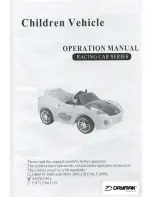
2
Thank you for your purchase of the Extreme Flight RC Jeremy Chinn designed
Matchless Yak-55SP profile ARF! We are honored to have worked with Jeremy on this
project to deliver a very high performance, high quality product. Jeremy has been
involved in prototype testing and we have listened to his suggestions and are very excited
about the outcome.
The Chinn Yak (as it is called by the Profile Brotherhood) was released previously as a
kit and quickly became a favorite among the Pro Bros. There are numerous build threads
and videos of this aircraft on the Pro Bro site (www.theprofilebrotherhood.com). When
looking for a new profile to produce the Chinn Yak was at the top of our list and
arrangements were made with Jeremy for Extreme Flight RC to produce an ARF version
of his beloved design.
The Chinn Yak excels at all things 3D! Enormous control surfaces provide extreme
authority in pitch, roll and yaw axis maneuvers. You may want to experiment with
slightly higher exponential values than you are accustomed to until you get used to this
amount of responsiveness. The Chinn Yak is an excellent platform to hone your 3D
skills with and its unlimited performance capability will provide hours of excitement for
the 3D enthusiast.
Tips for Success-Please read before beginning assembly!!!
1.
Read the instruction manual thoroughly before starting assembly.
2.
We are very pleased with the level of craftsmanship exhibited by the workers in
our factory. However, these are mass produced models. As with any ARF, take a
few minutes to go over the model and add CA to high stress areas or any joints
that appear to need more glue.
3.
Take a few minutes and go over the covering with a hot iron. Make sure all edges
are sealed and pay special attention to thin stripes.
4.
Decals-
clean your airplane with glass cleaner and a paper towel before starting to
apply the decals. Mist the area where the decal will be applied with glass cleaner
or water mixed with a little bit of soap. Use scissors to remove the decal from the
sheet. For best results cut as close to the edges of the decal as possible. Position
the decal in place and use a credit card or rubber squeegee to push the excess
liquid from under the decal and allow to dry. You may need to secure the edges
of the decal with masking tape to prevent them from rolling up until the solution
has dried and evaporated.



































